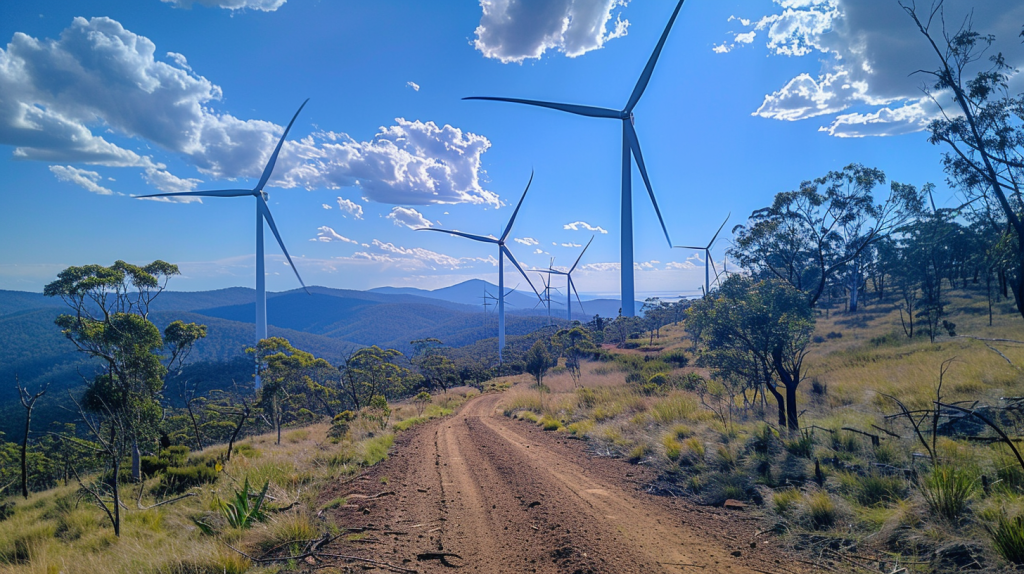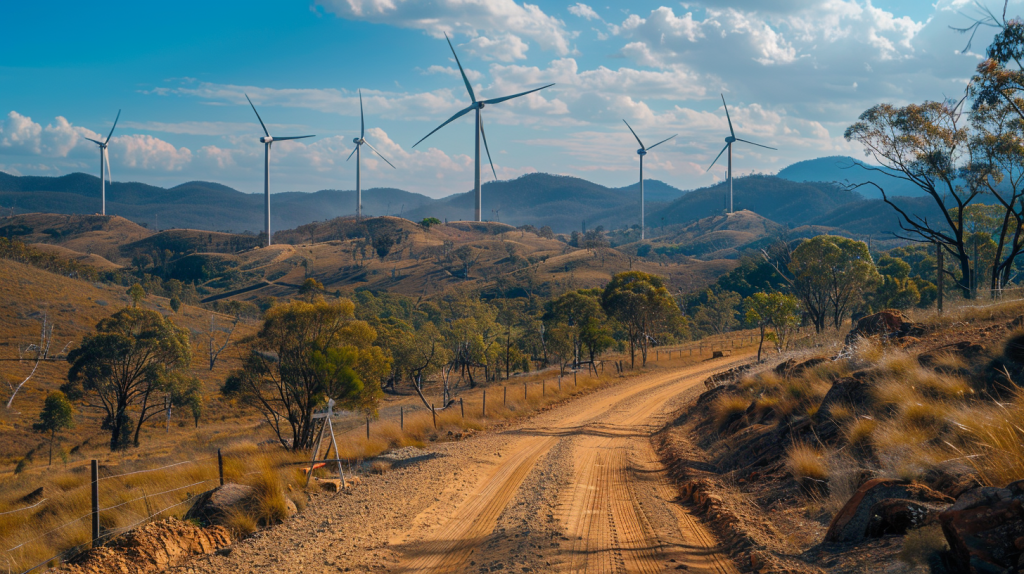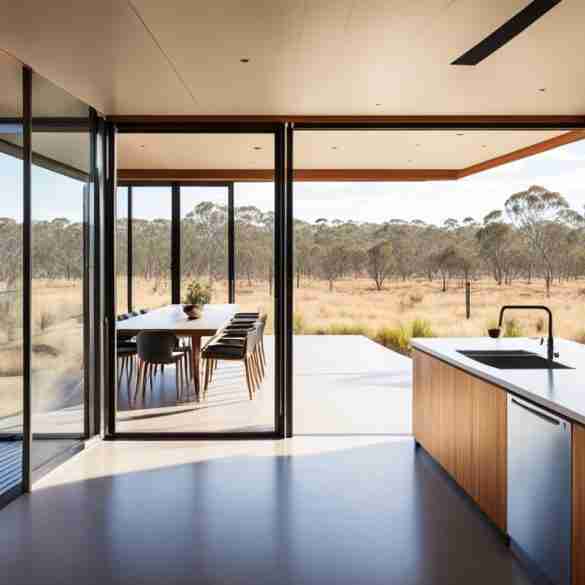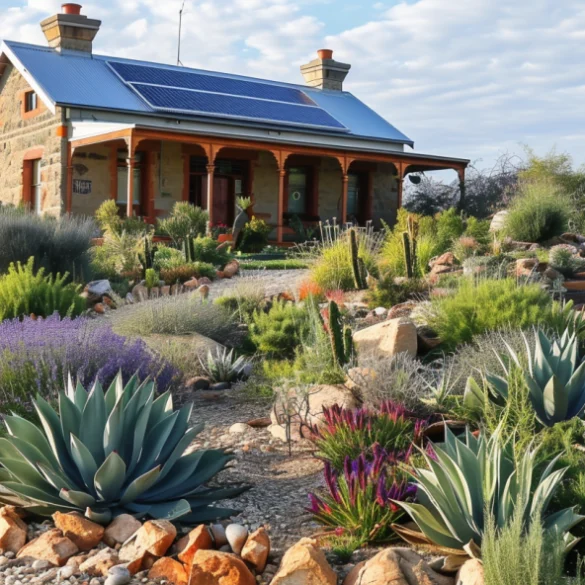Did you know Australia can handle a huge increase in wind energy without big issues other than community concerns1? This shows that the debate about wind farms is at its peak. Everyone from political leaders to local communities is involved.
Australia aims to build new wind farms quickly, but it’s not going smoothly2. Red tape slows the process, causing problems and disagreements in Australia2. People worry about how windmills will change the look of the land and the tensions they bring to neighbors.
Getting people on board and supporting these projects is key3. In Canberra, since 2015, the government has made community support a must for new wind farms3. Lacking support has even stopped some projects and made the future of green power unsure3. Wind farm workers are focusing more on talking directly to people to get better results3.
Wind farms can bring a money to local families2. An example in Nundle, New South Wales, one family could make almost $1 million a year for 30 years if a wind project is approved2. But, not everyone is happy about this. The topic of wind farms has divided local groups and caused arguments2. The national conversation about this green energy is mixed.
Key Takeaways
- Australia’s National Electricity Market can handle a huge boost in wind energy1.
- The country is working towards big wind farm plans2.
- Getting approvals for new wind farms is slow and not peaceful2.
- The ACT Government says talking to the community is a must for green energy projects3.
- Direct and long-lasting talks with people are the most successful3.
- Wind farm projects bring a lot of money to families but can lead to local issues2.
Table of Contents
Podcast about Wind Farms in Australia if you would like to listen to the main points about this article.
The Rise of Wind Farms in Australia
Australia is going big on green power with more wind farms popping up. This boom is helping a lot with making electricity. It all started with small wind projects that are now growing thanks to new technology4.
History of Wind Farm Use
In the early 1980s, Australia started building wind farms in far-off places. These early projects showed the potential of wind power. Wind turbines last about 25-30 years, which means a long life for clean energy sources4.
Wind power produced 35.9% of Australia’s clean energy in 2020. This shows how important it is for Australia’s energy future5.
Current Developments and Projects in Australia
Today, Australia is pushing ahead with big wind energy projects. ACCIONA Energía is leading this work, putting up over 12GW of green energy. They have projects in 20 countries, showing their global commitment to clean power4.
The Mt. Gellibrand Wind Farm in Victoria makes 132 MW, enough for 90,000 homes4. The MacIntyre Wind Farm in Queensland will be even bigger, making 1,000 MW. That’s a lot of power when it’s done4.

Australia’s wind energy potential is huge. The Murra Warra Wind Farm in Victoria, which started in 2020, is the biggest, at 226 MW5. In the same year, ten new wind farms added 1097 MW to the mix. Places like the Warradarge Wind Farm in Western Australia (184 MW) and the Cattle Hill Wind Farm in Tasmania (144 MW) are leading the way5.
More wind power means Australia can be greener. Many people also really prefer this to Coal generated energy.
Other than many people who live in areas where wind farms are built, 84% of Australians think wind power should be a top source of energy in the future6.
Big projects, like the Illawarra Offshore Wind Zone and the Gawara Baya Wind Project, could make Australia’s energy mix even better465.
Wind Energy Benefits with Wind Farms in Australia
Wind energy is a key player in the world of renewable energy sources. It plays a big part in creating power in a way that helps the earth and grows our money. Countries like Australia are using their strong winds well, leading to more green and more cash.
Renewable Energy Sources
Among green power sources, wind energy grows fast and has a lot of potential. By 2030, wind could make up 20% of the world’s power, up from 4 to 5% now7. It’s the second biggest green power, after water power7. In Australia, wind farms are doing more than other clean energies. They bring over 35% of the country’s green power and 9% of all electricity7.
Reduction in Greenhouse Gas Emissions
Wind power fights climate change by cutting down on harmful emissions. Windmills make power without polluting the air, helping to slow down global warming8. Using more wind power could cut CO2 emissions by more than 3.3 billion tons every year worldwide7.

Economic Benefits
Putting money into wind projects helps both the earth and our wallets. In Australia, investing in wind has hit $4.25 billion, with even more money planned9. Wind jobs are also a big deal. For example, a 50 MW wind farm needs 48 builders on average. This adds up to 160 construction jobs and 121 operation jobs, both directly and indirectly9.
On top of that, wind farms give back to farmers and local groups. They can pay up to $250,000 yearly to farmers and support local projects with $80,000 every year9.
In countries like the U.S. wind power is quickly becoming a top way to make electricity. It already supports more than 100,000 jobs and could create over 600,000 more8. In Australia, the wind energy field is also a strong job provider, offering varied incomes and big community benefits. This helps make the economy stronger9.
Wind Farm Environmental Impact
While helping the climate and economic benefits for energy costs wind farms also impact the existing environment in many ways.
They change where animals live, how places look, and how the land is used. While wind power is great for the Earth, we must also think about its effects on nature and people.
Impacts on Wildlife of Wind Farms in Australia
Wind farms affect animals in many places, causing them to move or act differently. Turbines can hurt seabirds, like when they hit blades and get hurt or die10. Ocean animals hear too much noise and find it hard to move around when wind farms are built in the water. This can harm them and even help bad plants and animals grow in the sea10.
The effects of erosion on our land and its impact on our national animals should not be taken for granted. Disturbed habitats and the introduction of unusual noise can affect the mating habits of our animals.

Aesthetic and Noise Concerns
One worry about wind farms is how they look and the noise they make. Changes to the coast can make places less pretty for visitors. This might hurt tourism and the money people make in the area10.
Also, the sounds wind turbines make can effect people and reduce how much their homes are worth. This impacts what living in the countryside feels like11. Such things can change how people feel about wind farms.
Land Use and Habitat Disruption
Building wind farms can take away animals’ and plants’ homes. This makes animals find new places to live. In the country, making space for wind farms can majorly shake up the area’s natural life10. So, when choosing spots for wind farms, we must think about how to protect nature and not cause too much damage.
Finding a good balance between making wind power and not spoiling nature too much is key for the future.
Wind Turbine Technology and Efficiency
Wind turbine technology is advancing, improving how wind farms work. It plays a big role in finding green energy solutions. This has changed how we collect and use wind energy.
Advancements in Wind Turbine Technology
New tech in wind turbines has boosted efficiency and cut environmental harm. These turbines now get energy better and worry less about loud sounds in the country12. They’re great for many places, from homes to big businesses, thanks to these upgrades12. But, they need lots of wind, so new things like power lines are often added13.

Efficiency of Modern Wind Farms in Australia
Today’s wind farms work better because of tech improvements. In the U.S., wind power creates 10% of all energy going to homes and businesses. Between 2010 and 2018, it doubled its power-making ability13. This growth lets over 30 million homes be powered by wind energy13. Plus, wind power is cheaper than using traditional fuels, making it a smart choice for the planet and our wallets13.
Latest advancements in Wind Farm Technology
Recent advances in wind energy technology are boosting green and powerful ways to make energy. By 2018, Australia had 94 wind farms, making 7.1% of its total energy. They had nearly 16 GW of energy-making power14. Around the world, more and more electricity comes from wind, a trend that’s expected to keep growing14. Soon, in Australia, wind energy will become cheaper, providing power for less than $50/MWh by 203014.
| Metric | Statistic |
|---|---|
| Global Wind Energy Capacity | 600 GW by end of 201814 |
| Wind Power in U.S. Energy Generation | 10%13 |
| Wind Energy Cost | $0.02 per kWh13 |
| Australian Wind Farms | 94 by end of 201814 |
Wind Farms in Australia Pro’s and Con’s
When we talk about wind farms in Australia, we need to think about both the good and the not-so-good. It’s important to consider the benefits against the potential harm to our environment and communities. Let’s dive into the details of the pros and cons.
Advantages
Wind Farms in Australia play a big part in making energy from renewable sources. They’re a good substitute for using up fossil fuels. In Australia, they’ve helped cut down on a lot of greenhouse gases15.
Besides, they bring in money for farmers who have wind turbines on their land16. Australia should also explore a model where residents share ownership and make some money, such as have worked well in places like Germany and Denmark because it involves locals deeply16.
Disadvantages of Wind Farms in Australia
With all the good things, wind farms can also cause some issues. People worry about the impact on the environment and its effect on animals and their homes16.
Plus, some folks are not happy about how wind turbines look or the noise they make. This can lead to fights within the community15. Developers are trying to make peace, thinking of ways, like special funds, to fix these problems and get the public to agree with wind projects17. Even though ideas like Benefit Sharing Mechanisms are there to help, they’re not used enough in Australia17.
| Advantages | Disadvantages |
|---|---|
| Renewable energy production, significant reduction in greenhouse gas emissions15 | Potential environmental impacts, wildlife and habitat disruption16 |
| Economic benefits, supplementary farming income16 | Aesthetic and noise concerns, community opposition15 |
| Community ownership, direct financial stakes for locals17 | Limited BSM implementation, need for more mechanisms in NSW17 |
The talk around wind power has many sides, with people making strong points from all views. With more and more wind projects happening in Australia, it’s key to find a balance. Tackling these benefits and issues is vital for making sure we produce energy in a way that’s good for everyone and our planet.
Sustainable Development and Wind Energy
Wind energy is key for our sustainable future. It uses nature to create green energy. Offshore wind farms are especially good, making more power with fewer machines. This helps as Australia works towards having no emissions by 205018.
Integration with Other Renewable Sources
Pairing wind with solar and hydro benefits us all. It makes energy more reliable. For example, combining wind and solar evens out power dips from weather changes. It cuts down on up and down times, making our energy flow steadier. It also helps us use different types of renewable power effectively.
Examples of Community Benefits and Challenges
Wind farms aren’t just good for the Earth. They help communities too, bringing jobs and boosting local economies. For instance, a big offshore wind project can put 1200 people to work and keep 600 working after it’s built18. These projects also pay taxes, benefiting places like Mower County, Minnesota, which got $2.3 million from these taxes in 201819.
Still, there are hurdles, like making sure the area is ready for the build and getting locals on board. Making the right infrastructure updates is vital for such projects to work20. Plus, getting the community’s support means carefully talking and listening to them throughout the project’s life18.
Health Concerns and Wind Farms
Wind farms are celebrated for adding to clean energy. Yet, they bring up health worries.
These usually include noise, how they look, and potential health risks.
Though many studies look into these issues, the gap between what people believe and what science shows can be big.
Reported Health Issues
Noise from wind turbines is a big concern for many. A study by Janssen and others found that even at low noise levels, people were effected21. The effect can lead to trouble sleeping and feeling anxious, especially for those who hear the turbines21. Shepherd et al. found that people living close to turbines had worse health quality compared to those farther away21.
Many people who are against wind farms because of health worries are often loud but small in number22. Polls by The Australia Institute show wind energy is highly popular, with 84% placing it at the top for future energy sources22. Knopper and Ollson highlighted a lack of research on the health issues of wind turbines back in 2011, pointing to the need for more studies21.
Scientific Research and Findings
But, despite these claims being circulated widely, science usually doesn’t back them. A detailed study from Verheijen and others found that health complaints from low-frequency noise under 45 dB(Lden) are rare21. Also, wind power is clean and doesn’t have solid proof of causing bad health effects22.
However a lot of studies are done on cost-benefit, environmental degradation, and issues with wildlife, more comprehensive research on health and mental effects should be undertaken in areas that have a longer-term history with wind farms to ensure people’s well-being.
Wind power is a big part of energy in many countries globally, with over 90 using it and 30 over 1 gigawatt in 201923. More research is key in addressing health concerns. It helps with better environmental studies too.
Political and Social Debate on Wind Farms in Australia
The debate over wind farms in Australia is a big issue. It combines thoughts from the government and the public. Currently, David Littleproud and Tanya Plibersek, key figures in the government, have different ideas about wind energy. They discuss its impact on the climate, economy, and environment.
Government Policies and Positions
Government rules are key in the development of green energy projects. More than 70% of Australians want renewable energy that doesn’t hurt local areas24. Yet, only 31% feel the country will achieve zero net emissions24. There’s also low support, just 35%, for 10,000 kilometers of transmission lines24.
Public Opinion and Advocacy
What people think affects the wind farm debate. It gets both support and derision from different groups, including climate experts, farmers, and firefighters. They’re sending very different information on their views on climate change24. However About 60% of Australians now back both offshore and onshore wind projects24.
Additionally, there’s huge community support. Unlike the 90% of people who are okay with living near a solar farm24, many people are not in favor of living near a wind farm. This shows people are open to clean energy options.
Case Studies and Real-life Examples of Wind Farms in Australia
Learning about wind farms can be interesting and educational. Let’s look at the Illawarra Offshore Wind Zone and the Gawara Baya Wind Project. These two projects are big steps in using renewable energy25.
Illawarra Offshore Wind Zone
The Illawarra Offshore Wind Zone is changing Australia’s energy game. It has many wind turbines in the sea off New South Wales. This project wants to make more energy without hurting the environment much22. People in the area like the idea of having clean energy around them. 84% of Aussies think wind power is a great choice for energy22.
Gawara Baya Wind Project
The Gawara Baya Wind Project is a step towards more clean energy in Australia. It’s creating jobs and helping local businesses. People in NSW support wind farms, even if they are near where they live25. This project is careful with the environment22. It uses new tech to protect wildlife. And, it’s keeping up with the world by storing energy26.
- High support for energy production using renewable technologies25
- Regional variation showing positive perceptions towards local wind farms25
- Technological advances reducing ecological impacts22
- Integration of advanced energy storage solutions26
Final Thoughts Wind Farms in Australia
The road through Australia’s wind energy scene is full of new technology, care for our planet, and a lot of people working together. Wind power has grown a lot, making up about 35% of Australia’s clean energy recently27. Thanks to new tech, wind turbines work better now. This makes them a strong option in the energy world. For example, Canunda’s wind farms can power up 34% of the time. They help provide electricity to many homes27.
Economically, the benefits are big. New wind projects are cutting costs and getting lots of money in the long run. But, people still talk a lot about wind farms. Big projects like Boco Rock and Taralga Wind Farms have costs in the millions28. Public support for wind energy is high. While 84% of people say it’s a top choice for future energy needs, only 38% see coal the same way22. It’s important to keep the balance, thinking about the environment and how things look.
As Australia keeps growing its wind energy, it will keep helping meet our energy needs and fight climate change. In 2018, wind farms made up 7.1% of the country’s power. They produced about 16 GW. The cost of wind energy is going down, making it more economical2728.
In 2016, the world’s wind energy capacity was 486 GW. This shows how big and important wind power is worldwide28. The path to this change has not been easy. But it shines a light on those who care about living in ways that are kind to our earth. The wind farm talk is ongoing. Over time, what we value and the tech we have will shape Australia’s journey with renewable energy.
Source Links
- https://australiainstitute.org.au/wp-content/uploads/2020/12/DP91_8.pdf
- https://www.abc.net.au/news/2024-06-10/wind-wars/103961010
- https://assets.cleanenergycouncil.org.au/documents/resources/reports/enhancing-positive-social-outcomes-from-wind-farm-development.pdf
- https://www.acciona.com.au/updates/stories/the-power-of-wind-how-wind-energy-is-transforming-australia-s-energy-landscape/
- https://www.cleanenergycouncil.org.au/resources/technologies/wind
- https://australiainstitute.org.au/wp-content/uploads/2020/12/WEB-Wind-energy-climate-and-health.pdf
- https://engie.com.au/blog/wind-power-the-ultimate-renewable-energy-source
- https://www.energysage.com/about-clean-energy/wind/pros-cons-wind-energy/
- https://www.agl.com.au/content/dam/digital/agl/documents/about-agl/how-we-source-energy/coopers-gap-wind-farm/cec-benefits-wind-energy-australia.pdf
- https://afta.net.au/offshore-wind-farms-the-impacts/
- https://www.integratesustainability.com.au/2019/06/26/wind-power-australias-wind-resources/
- https://justenergy.com/blog/wind-energy-pros-and-cons/
- https://www.solarreviews.com/blog/wind-energy-pros-and-cons
- https://arena.gov.au/renewable-energy/wind/
- https://www.aph.gov.au/DocumentStore.ashx?id=c37ecc34-deaa-419b-bcf3-5763a4301923
- https://comagecontra.net/Australia/WindPower.html
- https://www.environment.nsw.gov.au/resources/communities/EY-wind-farm-shared-benefits.pdf
- https://www.dcceew.gov.au/energy/renewable/offshore-wind/building-offshore-wind-industry
- https://www.treehugger.com/wind-energy-pros-and-cons-5097577
- https://www.anavo.com/learn/australias-5-challenges-for-its-offshore-wind-industry/
- https://www.ncbi.nlm.nih.gov/pmc/articles/PMC4063257/
- https://www.aph.gov.au/DocumentStore.ashx?id=fc74f18a-7613-4120-ab73-3e607187bd93&subId=304628
- https://science.howstuffworks.com/environmental/green-science/wind-turbines-health.htm
- https://reneweconomy.com.au/do-we-want-a-wind-farm-outside-our-window-what-australians-think-about-the-net-zero-transition/
- https://www.environment.nsw.gov.au/resources/actionmatters/community-attitudes-renewable-energy-150419.pdf
- https://www.rees-journal.org/articles/rees/full_html/2023/01/rees220022/rees220022.html
- https://www.solarflow.com.au/can-australia-be-powered-by-solar-and-wind
- https://www.ccrc.unsw.edu.au/sites/default/files/NARCliM/publications/evansetal2018.pdf








